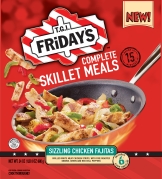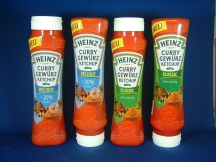"Natural" labels sticking less with manufacturers
Proposed irradiation process doesn’t want radura labeling
Grocery stores are shrinking. Will your SKUs wither, too?
T.G.I. Friday’s markets skillet dinners
German ketchup can flip

by Pan Demetrakakes
Executive Editor
Food companies that spend most of their time competing with each other are coming together in coalitions to advance industry-wide goals and burnish the industry’s image.
A group of more than 20 processors of organic and natural products has come together to form the Food Trade Sustainability Leadership Association (FTSLA). The idea is to have a network of leading companies, including Amy’s Kitchen, SunOpta and Nature’s Path Foods, to share best practices about sustainable improvements. Topics will include organics, climate change, energy utilization, distribution and waste management.
Companies in the FTSLA will commit to reviewing their sustainability practices in these key areas and report on them using shared metrics.
“Our vision is for the organic sector to lead the way in the transition toward a sustainable food system by demonstrating successful, sustainable business models that will, in time, become the beacon for the entire food industry,” an FTSLA spokesperson toldFoodNavigatorUSA.com.
In a similar development, more than 20 major food companies, led by General Mills, are joining to form the Food Safety Alliance for Packaging.
Wynn Wiksell, head of General Mills’ Packaging Quality and Regulatory Operations, says the coalition came together because its members realized that “food safety isn’t a competitive advantage,” but rather, something that affects the industry’s reputation as a whole. Its mission is to educate both material and equipment suppliers on food safety issues, and discuss steps the industry can take to ensure safety.
The Food Safety Alliance for Packaging will have its debut with a presentation Wiksell is scheduled to give at the Pack Expo trade show in Chicago’s McCormick Place. The presentation, entitled “Packaging HACCP: Food Companies’ New Expectations for the Packaging Supply Chain,” will take place at 8:30 a.m. Monday, Nov. 10.
TOP DEVELOPMENTS
"Natural” labels sticking less with manufacturersFood manufacturers are avoiding labeling a product “natural.” Why? Consumers are losing trust in the claim since the U.S. lacks a clear regulation, according to a Packaged Facts report. The report says “numerous natural/organic manufacturers stated in interviews…that they are avoiding using the term on labels, and instead relying on other value-added claims such as fair-trade, artisan and humanely raised.” While several manufacturers called for government-legislated rules for natural label claims, no move is expected in the near future.
Proposed irradiation process doesn’t want radura labeling
The United States Department of Agriculture (USDA) is considering a petition from the American Meat Institute (AMI) to allow the use of low-penetration and low-dose electron beam irradiation on beef carcasses without bearing the radura logo on the packaging. Irradiation of raw meat and meat by-products is already allowed by the USDA’s Food Safety and Inspection Service, but it requires the products to be labeled as “irradiated.” The AMI claims that the proposed treatment for chilled beef carcasses should be deemed a “processing aid” and should not require the radura symbol on packaging. A public meeting is being held today in Washington, D.C., but the agency will accept comments on the petition until Oct. 18, after which it will rule.
Grocery stores are shrinking. Will your SKUs wither, too?
Is a reduction or optimization of stock-keeping units (SKUs) in your future? Several supermarket chains-including Safeway, Jewel-Osco and British retailer Tesco-are experimenting with smaller grocery stores. They hope to appeal to time-pressed shoppers who only want to purchase a few items, such as prepared meals and fresh produce.
“The average person goes shopping for 22 minutes. You can’t see 30,000 or 40,000 products [in that time],” says Phil Lempert, editor ofSupermarketguru.com. “We are moving into an era when people want less assortment.”
So, how small is small? The Tesco Fresh & Easy stores, for example, are just 10,000 square feet. This compares to 47,000 square feet for an average grocery store and 2,615 square feet for a typical convenience store. According to Lempert, retailers will have to eliminate between 50% to 75% of the items sold in a typical store. “It’s time for [consumer packaged goods] companies to really shore up not only their consumer efforts, but their retailer efforts to make sure that they’re working as effectively as they can with retailers. Because [these retailers] are going to start taking their computer sheets and “x”ing things out,” Lempert says.
Sales are still brisk, however, for larger grocery stores and “super” centers. According to an article published in the Sept. 10 edition ofThe New York Times, the chains that are trying this smaller-store concept are hoping to capture new business, not cannibalize their existing customer base.

NEW PACKAGES
T.G.I. Friday’s markets skillet dinnersHeinz has come out with a line extension of its T.G.I. Friday’s frozen dinners that consist of individually packaged ingredients meant to be cooked as a one-skillet dinner. T.G.I. Friday’s Complete Skillet Meals comprise five flavors, including Sizzling Steak or Chicken Fajitas, Firecracker Sesame Chicken and Cajun Style Alfredo Chicken and Shrimp. The protein, vegetables and starches come in their own packets, allowing for variation in cooking times to suit consumers’ individual tastes.

A line of Heinz ketchup marketed in Germany comes in an bottle that can be stored on its closure if the consumer desires. Curry Gewürz (“spicy curry”) Ketchup comes in a slender, ergonomically shaped plastic bottle fromRPC Veryackungen Kutenholzwith a broad closure that can support the bottle for optimal product evacuation. The shrink sleeve on the 700-milliliter bottle is oriented top-to-bottom on one side and bottom-to-top on the other, for better merchandising and to suggest upside-down storage to the consumer. The multilayer bottle incorporates an oxygen barrier layer.
